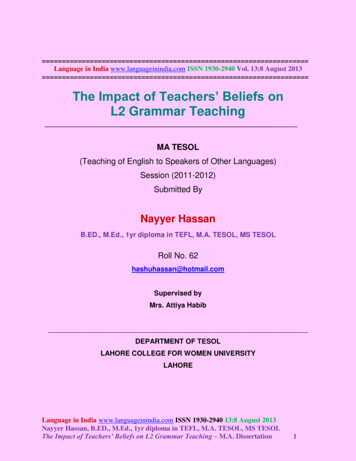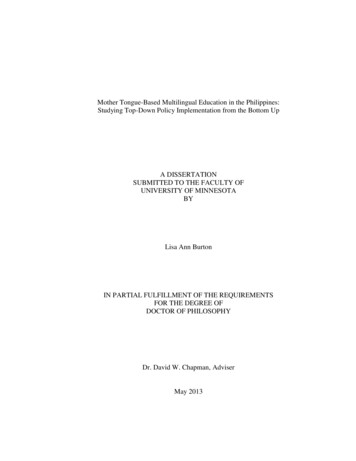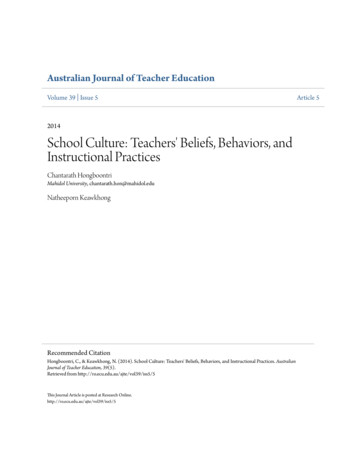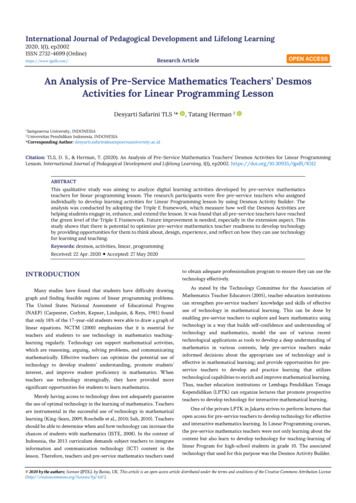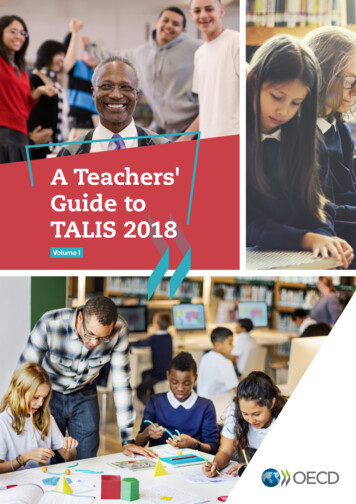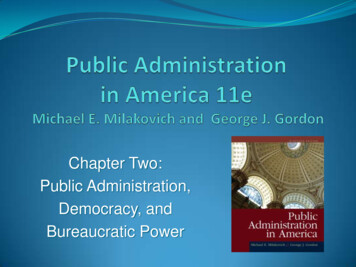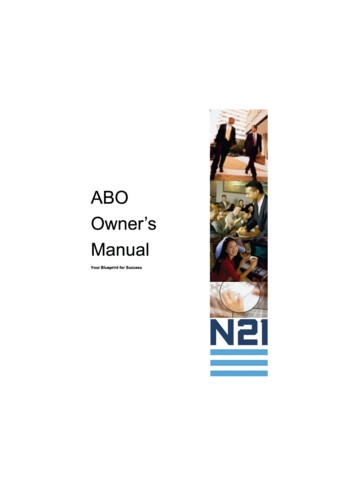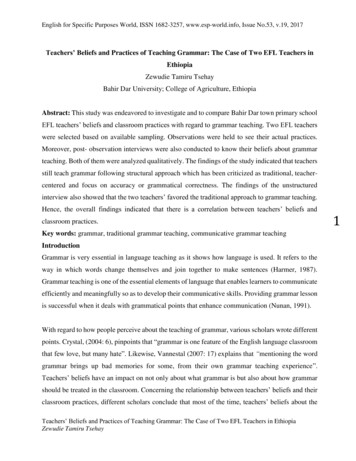
Transcription
English for Specific Purposes World, ISSN 1682-3257, www.esp-world.info, Issue No.53, v.19, 2017Teachers’ Beliefs and Practices of Teaching Grammar: The Case of Two EFL Teachers inEthiopiaZewudie Tamiru TsehayBahir Dar University; College of Agriculture, EthiopiaAbstract: This study was endeavored to investigate and to compare Bahir Dar town primary schoolEFL teachers’ beliefs and classroom practices with regard to grammar teaching. Two EFL teacherswere selected based on available sampling. Observations were held to see their actual practices.Moreover, post- observation interviews were also conducted to know their beliefs about grammarteaching. Both of them were analyzed qualitatively. The findings of the study indicated that teachersstill teach grammar following structural approach which has been criticized as traditional, teachercentered and focus on accuracy or grammatical correctness. The findings of the unstructuredinterview also showed that the two teachers’ favored the traditional approach to grammar teaching.Hence, the overall findings indicated that there is a correlation between teachers’ beliefs andclassroom practices.Key words: grammar, traditional grammar teaching, communicative grammar teachingIntroductionGrammar is very essential in language teaching as it shows how language is used. It refers to theway in which words change themselves and join together to make sentences (Harmer, 1987).Grammar teaching is one of the essential elements of language that enables learners to communicateefficiently and meaningfully so as to develop their communicative skills. Providing grammar lessonis successful when it deals with grammatical points that enhance communication (Nunan, 1991).With regard to how people perceive about the teaching of grammar, various scholars wrote differentpoints. Crystal, (2004: 6), pinpoints that “grammar is one feature of the English language classroomthat few love, but many hate”. Likewise, Vannestal (2007: 17) explains that “mentioning the wordgrammar brings up bad memories for some, from their own grammar teaching experience”.Teachers’ beliefs have an impact on not only about what grammar is but also about how grammarshould be treated in the classroom. Concerning the relationship between teachers’ beliefs and theirclassroom practices, different scholars conclude that most of the time, teachers’ beliefs about theTeachers’ Beliefs and Practices of Teaching Grammar: The Case of Two EFL Teachers in EthiopiaZewudie Tamiru Tsehay1
English for Specific Purposes World, ISSN 1682-3257, www.esp-world.info, Issue No.53, v.19, 2017best way to teach grammar is also reflected in their actual classroom teaching. Borg, 2003; Richardsand Farrel, 2005 also support this idea and point out that beliefs have a significant role in howeffective the teacher will be in the classroom.Similarly, in selecting or choosing the best way to teach grammar, EFL teachers will draw on theirbeliefs and these determine and justify what they choose to teach, how they teach and why theyteach the way they do. These beliefs will take the form of personal knowledge or personal theory.Teachers’ beliefs play a crucial role in how information on teaching is translated into classroompractice. Therefore, understanding teachers' beliefs is essential to improve teaching practices andteacher education programs in general (Johnson, 1994). In this regard, Eisenstein-Ebbsworth andSchweers’ (1996) findings as cited in Borg,(2003) show that beliefs about how grammar should betaught are largely shaped by teachers’ previous learning experiences much more than by the methodthat they learned in teacher training courses and subsequent Continuous Professional Development(CPD)-which explains why EFL/ESL teachers’ grammar teaching approaches are often outdated.Generally, due to “the absence of clear guidelines about teaching of grammar particularly insituations when, the contexts and environments within which teachers work, many of the problemsthey encounter are ill-defined and deeply entangled” (Nespor. 1987:324). This problem has ledteachers to create their own personal theories about how to approach grammar in languageclassroom and these personal theories are derived from their belief system (Borg, 1998).As a result,it is very vital to explore teachers’ beliefs about teaching English grammar and their actual classroom practices. Therefore, in this study, the researcher examined the case of two Ethiopian EFLteachers and investigated their beliefs and actual practices of grammar teaching.The ProblemAs aforementioned, teachers’ beliefs is said to be one of the factors which could affect the processof learning grammar. If teaching is mainly the result of a teacher’s personal beliefs, there is a needto study the correlation between teachers’ beliefs about teaching grammar and their classroompractices. Many researchers have recognized the significant role English language has in Ethiopianeducation system. For instance, Wartenberg (2001:18) argues that, “the English Language isindispensable, because it is the language of instruction for secondary schools (9-12) and for highereducation”. Ethiopian students should at least know good English in order to be competent in theirTeachers’ Beliefs and Practices of Teaching Grammar: The Case of Two EFL Teachers in EthiopiaZewudie Tamiru Tsehay2
English for Specific Purposes World, ISSN 1682-3257, www.esp-world.info, Issue No.53, v.19, 2017future life. Though knowledge of the English language is considered as a key to success in educationparticularly at the secondary and tertiary level, students are also expected to have a good knowledgeof English right from the primary level itself. This is because unless a foundation is laid for childrenat this stage, learning would become a difficult task later in their secondary and tertiary schools.In Ethiopian context, as far as the researcher’s reading concerned, grammar has been taught almostin all schools including primary schools. However, when students join universities, there are stillcomplaints on the part of teachers about students being communicatively incompetent whichincorporates also their grammatical incompetence. Thus, from the researcher’s personal experienceand informal discussion with colleagues, students at tertiary level have failed to communicate theirideas both orally and in written. On the contrary to this fact, the current literature states that grammaris being taught communicatively so as to enhance the students overall communicative competenceand the tasks designed in communicative grammar teaching is also varied which allow the studentsto engage in a more meaningful, interactive manner and encourages EFL/ESL teachers to applycommunicative activities. In relation to this, Saricoban and Metin (2000) explain that teaching is anart, which requires innovative and creative ideas to enrich its effectiveness and EFL teachers mustnot hesitate to use various communicative tasks such as games, simulations, role plays and all otheravailable resources in the classroom. The authors further emphasize that the teaching of grammarshould be supported by such techniques so as teach enhance communicative grammar.Therefore, this communication breakdown in the absence of correct use of grammar observed bythe students and colleagues’ complaint instigated the present researcher to investigate primaryschool EFL teachers’ beliefs and classroom practices of teaching particularly on grammar teachingsince nowadays, the teaching of grammar is becoming controversial. In this regard, Corder (1988)states that there is still ongoing debate about the best way to teach grammar. As suggested by Farrell(2004a,b), and Richards and Farrell ( 2005), opportunities should be provided for teachers to reflecton their work so that they can be encouraged to articulate and reflect on their beliefs while alsoinvestigating any mismatches between their beliefs and classroom practices.In relation to the teaching of grammar, there are a number of related studies conducted in the areain global as well as local level. Neyyer Hassen (2013) for example, investigated the impacts ofTeachers’ Beliefs and Practices of Teaching Grammar: The Case of Two EFL Teachers in EthiopiaZewudie Tamiru Tsehay3
English for Specific Purposes World, ISSN 1682-3257, www.esp-world.info, Issue No.53, v.19, 2017teachers’ beliefs on L2 grammar teaching in India Lahore College for Women University. Herfindings have shown that there is a strong correlation between teachers' beliefs about teachinggrammar and their classroom practices. In a similar vein, Habtamu Adem (2011) conducted aresearch entitled ‘‘Teachers’ and Students' Perceptions of Effective Grammar Teaching.'' Hisfindings have also indicated that there is a match between teachers' beliefs about teaching Englishgrammar and their classroom practices of teaching it.Novertheless, as to the present researcher’sknowledge, there is no specific study which has been conducted to investigate the case of twoEthiopian (Zenzelima primary school) EFL teachers’ beliefs and practices of teaching grammar andthis makes this study different from the previous similar studies. Hence, in this study, the researcherinvestigated the case of two EFL teachers’ beliefs and classroom practices’ regarding teachinggrammar at Zenzelima primary school and attempted to answer the following two researchquestions.1. What are EFL teachers’ beliefs about grammar teaching?2. How do EFL teachers’ teach grammar?Review of Related LiteratureThe Role of Grammar in English Language Teaching“In the past one-hundred years, there has been a spirited debate about what would be the best wayto teach a language” (Brown, 2001:16).Regarding the teaching of grammar, Atkins, Hailom andNuru, (1995) point out that grammar plays a primary importance in language teaching. The writersindicate that traditionally, grammar is regarded as a structure base-structural approach. They saythat this traditional grammar focuses on asking questions about the ‘form’ of the grammar itemsrather than the ‘meaning’ of the sentence in a context. As to the authors, traditionally, the studentswere supposed to learn about the language rather than to use the language communicatively. Asimilar point was also raised by Stern. He argues that “the main concern of the structural approachis to know the language” (Stern, 1983:140).Grammar, which gives sense to language, is an important part of language we use in everydaycommunication. It is considered as an essential element of language teaching. Any language issystematically organized by its grammar that is inextricably linked to meaning and communication.It is very difficult to make meanings clear without shaping grammatical and linguistic structuresTeachers’ Beliefs and Practices of Teaching Grammar: The Case of Two EFL Teachers in EthiopiaZewudie Tamiru Tsehay4
English for Specific Purposes World, ISSN 1682-3257, www.esp-world.info, Issue No.53, v.19, 2017(Frodesen and Holten, 2003). It is true that grammar plays a significant role also for Ethiopianstudents as well as even for EFL or other teachers and in general for educators.To take an instance, in Ethiopia and people in the rest of the world who want to continue theirstudies abroad especially in the USA or the UK have to take an intensive course in grammar in orderto pass exams like the Test of English as a Foreign Language (TOEFL) and the International EnglishLanguage Testing System (IELTS). Like IELTS, TOEFL is a kind of English proficiency testincluding listening, speaking, grammar, reading comprehension and a short composition on a giventopic. Hence, for many people who get scholarship, knowledge of the English language includingknowing the grammar is considered as fundamental. In this regard, Nachiengmai (1997) point outthat knowledge of grammar is what separates the educated from the uneducated.The teaching of grammar has given different places and emphasis at different times. For instance,during the GTM, ALM and other traditional methods, the teaching of grammar is considered as themain pillar in language acquisition. Where as in communicative language teaching, the role ofgrammar, the emphasis given for it becomes very less and rather priority is given to thecommunicative use of language (Widdowson, 1978).Concerning the role educators have given for grammar teaching during the introduction of CLT,Celce-Murcia, (1991) describes that the beginning of communicative language teaching has atremendous impact on the way language should be taught and learned. She adds that it is a turningpoint for linguists and language educators to seriously review the role of grammar in languageteaching and thus since the emergence of CLT in language teaching, questions such as “Shouldgrammar be taught?”, “When should grammar be taught?”, “What grammar should be taught?”, and“How grammar should be taught?” have been asking by English language teachers all over theworld (Celce-Murcia, 1991).In the communicative language teaching approach, the goal of language teaching is to develop“communicative competence” (Hymes, 1972). Helping students to develop their communicativecompetence is the central aim of foreign and second language teaching/learning. In this regard,Celce-Murcia (1997) states that communicative competence is the foundation of communicativeTeachers’ Beliefs and Practices of Teaching Grammar: The Case of Two EFL Teachers in EthiopiaZewudie Tamiru Tsehay5
English for Specific Purposes World, ISSN 1682-3257, www.esp-world.info, Issue No.53, v.19, 2017language teaching and there is a strong relationship between linguistic competence andcommunicative competence. Linguistic competence is the spontaneous and correct manipulation ofthe language system. Communicative competence involves principles of appropriateness andreadiness on the part of the learner to use relevant strategies in coping with certain languagesituations. Besides, linguistic competence is the basis of communicative competence. Withoutlinguistic competence, there is no communicative competence (Wilkins, 1976; Stevick, 1982; Stern,1983).Therefore, from the above statements it is possible to deduce that even in a communicative languageteaching, as far as the aim of language teaching is to promote learners communicative competence,grammar has a pivotal role whether in the traditional or in the recent ELT teaching methods and thebig question should be how grammar should be taught communicatively so as to make students touse the English language rather than a mere argument about whether grammar should be taught ornot. In general, Nachiengmai (1997) concludes that grammar is viewed as one component ofcommunicative competence. Grammar interacts with meaning, social function and discourse or acombination of these rather than being a system to be learned for its own sake.Phases of Grammar TeachingThe Presentation PhaseHarmer (1987:17) defines this phase as the phase which “students are introduced the form, meaningand use of a new piece of language”. The best way is to present the language item in a meaningfulcontext. In this phase of grammar teaching, the activities are controlled by the teacher. He/she mightuse a text, an audio tape or visual aids to demonstrate a situation or to present the lesson.The Practice PhaseIt is the second phase of the organization of teaching grammar for communication purposes. Here,skills are learned by doing or through constant practice Harmer (1987). Ur (1988) identifies thatthis is the phase at which learners are given intensive practice in new structure, but their productionof the language is very carefully guided and controlled by the teacher, so that correct form andmeaning are consolidated and the possibility of error is reduced to a minimum. This makes theteacher role decisive. The teacher models the language item and learners have the opportunity topractice the language. The most common technique is drilling so as to involve the whole class topractice. In the practice stage, Ur (1988) also strengths her idea and suggests that teachers shouldTeachers’ Beliefs and Practices of Teaching Grammar: The Case of Two EFL Teachers in EthiopiaZewudie Tamiru Tsehay6
English for Specific Purposes World, ISSN 1682-3257, www.esp-world.info, Issue No.53, v.19, 2017assist the students and help to avoid excessive errors and gradually reduce the control and movethem to the final stage which makes students relatively free to use the language.The Production PhaseAt this stage, the learners use the language meaningfully to communicate and complete messages.Therefore, teachers focus should be more on fluency, the ability to use the language rather thanaccuracy. Ideally, at this stage, students are free to say whatever they want. They choose thedirection of their conversation (Celce-Murcia, 1988).7Teachers’ Beliefs and Practices of Teaching Grammar: The Case of Two EFL Teachers in EthiopiaZewudie Tamiru Tsehay
English for Specific Purposes World, ISSN 1682-3257, www.esp-world.info, Issue No.53, v.19, 2017Fig 1: A three dimensional grammar frameworkMeanings/semanticsLexical meaningGrammatical meaningForm/structureMorphosyntactic and aticsSocial contextlinguistics discourse contextpresuppositions about context8Larsen-Freeman (2001:252)These three-dimensional framework of grammar developed by Larsen-Freeman (2001) consistingof form, meaning, and pragmatics. The three parts are closely interconnected with each other. Inthis framework, teaching grammar means enabling students to use linguistic forms accurately,meaningfully and appropriately. Larsen-Freeman (2001) notes that for effective grammar ough the PPP procedures played their own role for effective grammar teaching as LarsenFreeman (2001) points out, it is not free from flaws. From the 1990s onwards, this approach cameunder sustained attack from academics. Some of the major problems associated with it arementioned here. For instance, as Ellis (2003) explains, PPP views language as a series of productsthat can be acquired sequentially as accumulated entities. However, SLA research has shown thatlearners do not acquire a language in this way rather they construct a series of systems, known asinterlanguages, which are gradually grammaticized and restructured as learners incorporate newfeatures.Teachers’ Beliefs and Practices of Teaching Grammar: The Case of Two EFL Teachers in EthiopiaZewudie Tamiru Tsehay
English for Specific Purposes World, ISSN 1682-3257, www.esp-world.info, Issue No.53, v.19, 2017Furthermore, research on developmental sequences has shown that learners pass through a series oftransitional stages in acquiring a specific grammatical feature such as negatives, often taking monthsor even years before they arrive at the target form of the rule. In other words, L2 acquisition is aprocess that is incompatible with teaching seen as the presentation and practice of a series ofproducts. Hence, PPP is seen as lacking a firm basis in second language acquisition (SLA) theory;being too linear and behaviorist in nature, so failing to account for learners’ stages of developmentalreadiness (Ellis, 2003). Thus, it is unlikely to lead to the successful acquisition of taught forms(Skehan, 1996). In addition to these, Lewis, (1993) also criticized this model and argues that it isteacher-centered and does not reflect the nature of teaching and learning since it considers learningas straightforward and teaching as rigid. Generally, Lewis (1993) concludes that PPP wasinadequate because it reflects neither the nature of language nor the nature of learning.Therefore, even though the PPP has been applying for many centuries, unless the teachers’ creativityis added to make PPP presented in a very smart way, the previous way of PPP required students tomerely mimic a model in a fixed linear order without paying attention to the inherent complexitiesof the language itself as well the teaching/learning process and it was simply time bounded; it didnot give a chance for both teachers and students to adjust the lesson in the way they preferred.Approaches to Grammar TeachingDeductive versus Inductive ApproachesIn a deductive approach, the teacher explicitly states grammar rules. Rules are exhaustivelypresented before examples are provided whereas in the inductive approach, there is no explicitpresentation of rules. The students are made to discover the structures or may be asked to drive therules that govern it from meaningful context/examples. Deductive grammar instruction is related torules driven instruction whereas inductive grammar deals with discovering the rules. Deductive andinductive approaches are related to deductive reasoning which is from general to specific where asinductive reasoning is from specific to general respectively (Rutherford, 1987).Explict, Implict and Inclusive ApproachesExplicit approach also known as formal instruction, overt grammar teaching, product orientedapproach or deductive approach. It is an approach to teaching grammar which overtly presentsgrammatical rules (Harmer, 1987). In this approach, the teacher provides explicit grammatical rulesTeachers’ Beliefs and Practices of Teaching Grammar: The Case of Two EFL Teachers in EthiopiaZewudie Tamiru Tsehay9
English for Specific Purposes World, ISSN 1682-3257, www.esp-world.info, Issue No.53, v.19, 2017and explanations for students. The assumption behind explicit instruction is rules that are learntconsciously can be converted in the unconscious process of comprehension and production(Cook,2001).Nonetheless, this statement contradicts with Krashen’s (1985) statement in his‘acquisition-learning’ hypothesis in that learning cannot turn into acquisition which is of course oneof his criticisms.Regarding implicit approach, it is also known as inductive teaching, skill oriented approach, covertinstruction. It is an instruction whose aim is raising the learners’ consciousness of specificgrammatical structure (Rutherford and Smith 1985 as cited in Habtamu, 2011). Consciousnessrising refers to the deliberate attempt to draw the learners’ attention specifically to the formalproperties of the target language (Habtamu, 2011). Harmer (1987) views this approach as a teachingof grammar where grammatical facts are hidden from students.Inclusive approach to teaching grammar also known as balanced approach or integrative approachwhich is a combination of explicit and implicit approaches but it neglects their draw backs (Atkins,Hailom and Nuru, 2005). Sysoyev (1999) names this approach as integrative grammar teachingwhich consists of three Es (EEE) which stand for Exploration/inductive, Explanation/deductive andExpression where learners are allowed to apply their knowledge of grammar to express themselves(to produce meaningful sentences). Therefore, in EEE method explicit and implicit instructions areintegrated while teaching a lesson. According to him, there can be two ways to teach grammar inthe inclusive approach one is by taking the positive sides of explicit and implicit approaches andintegrating them and the other one is by applying either explicit or implicit alone depending on thecontext and their appropriateness where ever they required to fit for a purpose.In general, although the authors gave different names for explicit, implicit and inclusive approachesto grammar teaching, when one reads deeply, it seems that there is no such a huge difference lectic approaches to grammar teaching and hence in my understanding, Itook them as one as long as their purposes are very similar.Focus –on- form, focus –on-forms and focus-on-meaning instructionTeachers’ Beliefs and Practices of Teaching Grammar: The Case of Two EFL Teachers in EthiopiaZewudie Tamiru Tsehay10
English for Specific Purposes World, ISSN 1682-3257, www.esp-world.info, Issue No.53, v.19, 20171. Focus-on-form-draws learners’ attention to the form/structures with in a meaningful context. “Itrefers to any planned or incidental instructional activity that is intended to induce language learnersto pay attention to linguistic forms” (Ellis, 2001:1-2).2. Focus-on-forms-traditional, form alone.3. Focus-on-meaning instruction-meaningful use of L2 in context.Krashen and Terrell’s “Natural Approach to Second Language Acquisition” is a good example offocus on meaning instruction (Brown, 2001; Spada,and Lightbown 1993; Ellis, 2001).This approach“completely refuses any direct instruction on grammar, explicit error correction, or evenconsciousness-raising, as L2 is claimed to be naturally acquired through adequate exposure tolanguage or “comprehensible input” (Krashen,1985:2). According to this view, explicit knowledgeabout language and error correction is unnessarly and even harmful as it may interfere with thenatural acquisition process which learners would subconsciously analyze the forms and eventuallydeduce the rules from the language input themselves (Krashen, 1982; Larsen-Freeman, 2003).Nevertheless, both focus on forms and focus on meaning have been subjected to serious criticisms(Long, 2000). Focus-on-forms has been criticized for being teacher-centered artificial, boring andfor not allowing meaningful communication and interaction, which are essential to languageacquisition (Long, 2000). Likewise, focus-on-meaning has also limitations as it allows only a floodof language input with no attention to grammar or error correction which results in fossilization andpoor L2 grammar in language production (Swain, 1985).Techniques of Communicative Grammar TeachingThe presentation of grammar in a contextual, meaningful and purposeful manner is calledcommunicative grammar (Nachiengamai, 1997). In language learning, mastery of the forms wouldbe valueless without equal mastery of the meanings they convey. This shows that grammatical formsand grammatical meanings are equally important in language teaching. According to Dickens andWoods (1988:45) “Communicative grammar consists of content and construct, content refers towhat is being presented to students and construct addresses how the content is being presented tolearners via grammar learning tasks.” They further notify that grammar and communication are seenas two complementary elements needed for effective language use. In other words, communicativegrammar is concerned with ‘content’ and ‘construct’. In relation to the ‘how content is beingTeachers’ Beliefs and Practices of Teaching Grammar: The Case of Two EFL Teachers in EthiopiaZewudie Tamiru Tsehay11
English for Specific Purposes World, ISSN 1682-3257, www.esp-world.info, Issue No.53, v.19, 2017presented’ in a communicative grammar, Saricoban and Metin (2000), suggest the followingtechniques of presenting grammar communicatively.1. Pictures- carefully designed pictures have the potential to motivate students and to respond morethan a text because they are contextualized than students’ textbooks.2. Graphs-are free to different interpretations and are able to entertain learners to differentlanguage usages.3. Games –particularly play an important role to make the learner use the languagecommunicatively and to practice the grammar items.4. Role-Play- it is very useful to contextualize any grammar items and improve students’communication skills. This technique also helps students to express their ideas using their ownwords, to dramatize. It is funny and dramatic so students are able to pretend and learn a lot fromeach other.5. Songs- most songs are authentic materials and are rich in context.6. Poetry- Poems like songs create image about cultural practice and reflect moral feeling of asociety.7. Telling stories. Most people like stories especially stories are enjoyable for children so thatprimary school teachers should select interesting stories which can be used to present the grammaritem in a meaningful context and students induce both meaning and form from the story.8. Problem-solving activities- the problems are either real or imaginary situations. They providefavorable conditions and usages for extended communicative practice of grammar.Communicative grammar activities can help learners use the language appropriately in a givensituation.To sum up, the aim of grammar teaching in primary schools should not be simply to let students tomemorize a mere collection of grammar items; instead, it should be to promote the students’ overallcommunicative competence. Hence, communicative grammar teaching is very crucial for thestudents so as to communicate with others either in spoken or written. In this regard, LarsenFreeman (1986) underlines that using the above various techniques can assist teachers to create arelaxed atmosphere which is enjoyable and motivating for the students and contributes a lot to bringthe structural, semantic and communicative aspects of language in the classroom.Research MethodologyTeachers’ Beliefs and Practices of Teaching Grammar: The Case of Two EFL Teachers in EthiopiaZewudie Tamiru Tsehay12
English for Specific Purposes World, ISSN 1682-3257, www.esp-world.info, Issue No.53, v.19, 2017In order to answer the above questions, the researcher employed a qualitative study. The cases oftwo EFL primary school teachers were being investigated and compared.Participants of the StudyTwo English language teachers of Zenzelma primary school, which is found in Bahir Dar, Ethiopia,were selected as participants.Sampling TechniquesThe study employed both purposive and available sampling techniques to choose the school and theresearch participants respectively.Data Gathering InstrumentsThe researcher used two data gathering instruments: observation and unstructured interview. Themain purpose of a post-lesson interview was to gather informa
Teachers’ Beliefs and Practices of Teaching Grammar: The Case of Two EFL Teachers in Ethiopia Zewudie Tamiru Tsehay 4 Review teachers’ beliefs on L2 grammar teaching in India Lahore College for Women University. Her findings have shown that there is a strong correlation between teachers' beliefs about
